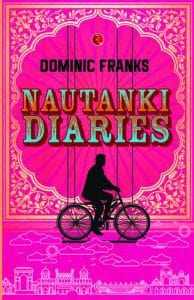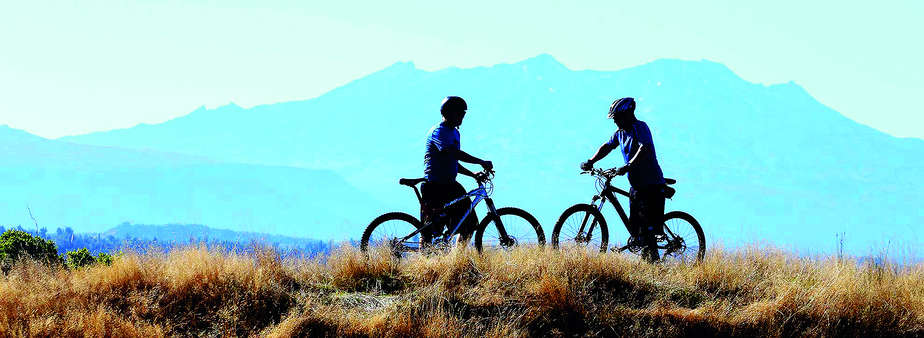You can fly. Or you can get astride your hardy bicycles to pedal down tarred roads to coveted destinations, regardless of the harsh elements and the lack of creature comforts
Curiously, not one but two books about cycle yatras have come out in the last couple of months. The recurring theme suggests that even in this jet age of ‘breakfast in Berlin, dinner in London’, and ubiquitous private SUVs, there are still some people who want to explore a route inch by inch. They want their itinerary to be decided by their bodies’ level of fitness and muscularity, and the freedom to take as many photos/videos as possible, in an era where if it’s not on Facebook, it never happened.
Both books — Nautanki Diaries by Dominic Franks (Bengaluru to Delhi) and Kailash Manasarovar: Cycle Rides, Soul Journeys by Anita Karwal and Anurita Rathore — give their cycles a character and a voice. While Franks names his bicycle Nautanki, the two women authors have chosen to tell their tale in the voice of a cycle, a curious stratagem that does not work too well. The style is witty enough, but the narrative would not have lost its charm if it came from a warm-blooded human rather than a machine which has to be periodically dismantled to be loaded on trucks, and takes an hour to re-assemble.
However, that’s a mere quibble. The not-so-young group of 14 from Ahmedabad, in their mid-thirties to forties, who set off for an unusual pilgrimage to the sacred mountain in China, are not all physically fit. Some of them form the support group which will travel by motorised vehicles, providing food and drink, carrying tents and supplies, taking photographs and jotting down notes. They have recruited the services of a travel agent from Delhi, who provides the equipment on rent at Kathmandu. The nine cyclists, mostly from the Ahmedabad Cycling Club, have brought their own saddles, according to their girth and wait, preventing pain in the wrong places.

It will no doubt make Indians feel better about our country to be told that on the Chinese side, in Tibet to be precise, there is sloppy immigration clearance, unnecessarily aggressive and intrusive security, and a deplorable lack of toilets. They see no facilities like hospitals or schools for the locals along the way. They are forced to part with money when the drivers go on strike just when they are most vulnerable, with some campers falling sick, to be mollified only by a fat pad of yuan. Tourists are obviously not treated like gods on both sides of the border. And even in these remote hills, a couple of garishly dressed women, overly made up, come to explore the possibilities of male attention. It is only when they reach Darchen, a small town “abuzz with tourists”, the starting point for the parikrama of Mount Kailash, that they stayed in a proper motel, but here again the standards of hygiene are deplorable. This is China, the superpower?
The breathtaking beauty of the Himalayas on the route cannot be conveyed in words, or even the colour pictures in the book. That, perhaps, has to be experienced with one’s own five senses. The physically arduous journey too is a challenge that the group overcomes with relative ease, despite not being athletic. This, perhaps, is what random readers would want most from the book – the hows and wherefores of the journey, and whether it should be attempted at all. The use of cycles seems to be an act of bravado, just like the motorcycle rides from Srinagar to Leh, quite a rage with the younger generation. Self-confessedly, it is done as an extreme sport, to earn bragging rights. Fortunately for this group, their leader is a doctor who is also good at engineering jugaad and back massages. Otherwise a group’s health and even survival would have been at risk.
Here goes a sample of the writing, which sparkles throughout:
“When you are in the middle of nowhere, with only a water-proof cloth in the shape of a tent separating you from the star-studded sky above and the green-brown earth below, with not a living being in sight other than the ones who are similarly place right next to you, you sleep like you have never slept before. In the middle of the night, therefore, if you are woken up for something that is not even the tip of an emergency, what do you think will be the force of combined tempers? Exactly!” (It turns out to be a 4 am request by one of the campers for tents to be lit from inside for a photograph.)
For Franks, on the other hand, the journey is a kind of spiritual quest, a discovery of himself and his country. He wants to re-trace the route taken by his sports instructor HP Sivaprakash ‘Shikaari’, who had cycled to Delhi to watch the 1982 Asian Games. The author had been dreaming of repeating this feat for the 2010 Commonwealth Games. An ex-colleague from the television industry, on hearing of his proposed yatra, asks to go along in a car recording the journey with a three-member crew. He agrees, as long as he is not asked to play-act. He looks for advice from his cycling gurus:
“To my mind, Shree was the God of cross-country cycling. He had cycled over 12,500 km of India’s vast sweeps in five trips. He had also responded to my first email with incredible speed—11 minutes. The previous day, I had met him to tap into the bank of his experience. I was surprised at his girth, but remembered he was recovering from a back injury. Shree suggested I put in three back-to-back 100-km days before I took off. His reasoning was simple: I had never attempted a long cycle ride before, and was better off finding out my limitations before I set out. Besides, he argued, ‘It will be a solid confidence booster before the trip’.”
Franks chooses the route Bengaluru-Hyderabad-Nagpur-Gona-Agra-Delhi, a grueling journey that reveals much about India’s poverty, lack of opportunities in rural areas and traffic chaos. It is a lonely journey, except for small stretches when another cyclist becomes a silent companion for some hours or minutes. There is suspense in it for him, about whether he will make it to his destination, but none for the reader, who knows it must be a done deal, otherwise there would be no book.
Both the travelogues under review are a bit lacking in context, as the yatris know nothing about the history of the lands they pass through. No prior reading has been done, forgiveable in the case of Franks, (as not much literature would be available about the hinterland) but not so for the pilgrims, who confess to knowing nothing about the Tibetan plateau before starting out. Wouldn’t the journey have been richer if they knew what to look out for, the terrain, the society, the ecology? But the group was obviously so caught up in its own group dynamics that we can only envy their camaraderie, not gain from their knowledge.
To conclude, a quote from Nautanki Diaries, which explains both the desire to do cross-country cycling and the urge to write a book about it:
“What is that strange happiness that comes to cyclists when they battle with their bodies while hardening the mind—playing games with it, telling jokes to it, cajoling it, berating it, urging it to stay with the rhythm? For how long can you really go?”
Nautanki Diaries is published by Rupa and Kailash Manasarovar by Readomania





